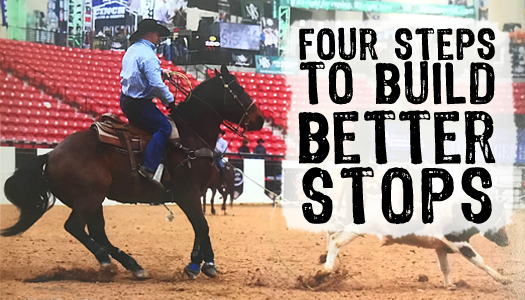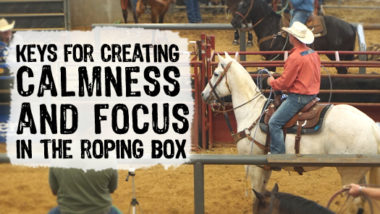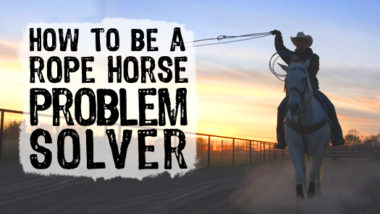Listen to this article in audio form! It’s #4 in the Team Roping Tips Podcast.
For the latest episodes subscribe on iTunes or your favorite podcast app.
Team roping is one of the fastest growing equine sports in the U.S. This means it’s also becoming more competitive than ever. Not only do we need to rope our steers extremely fast, but we also need to have clean, penalty-free runs.
In today’s post, I’ll be sharing how you can do both more consistently by improving the quality of your horse’s stops.
It might seem as though this would only apply to heelers, but our horse’s ability to stop well is directly connected to their athleticism in general, so it’s an area to focus on for headers as well.
It’s not uncommon to think that “it is what it is,” and either our horses are naturally great stoppers, or they aren’t. While genetics certainly play a part, the role we play in bringing out each horse’s athletic potential with purposeful training can’t be understated.
We have so much more influence on this than many realize, and the power to make a good horse great, and a great horse even better, is literally in our hands.
“The better your horse stops, the better he’ll do everything else.”
Establishing a great stop in a horse has benefits that extend well beyond being fast and consistent in the roping pen.
This is because any time there is stress put on the body in an imbalanced way, the soft tissues have to work overtime to oppose that repetitive stress, which creates excess wear & tear. When a horse hasn’t been educated to stop with good position and timing, or is inverted & bracing in their body vs. more supple and round, this physical tension and resistance leads to hesitation, pain and eventually break down.
If you’ve ever had a nice horse stop working, you know from experience that it’s better to do everything you can to keep them working. Balanced, collected stops (and movement in general) allow our horses to perform in a way that is supportive of their physical/mental soundness and longevity over the long haul.
If you look at a lot of the photos of the top heelers, you’ll see that their horses are arched through their back, have flexion at the poll, and their hind end is deep underneath their body. This position prepares them to take a jerk from a steer in a way that’s balanced over a sturdy foundation. A solid base of support helps a horse be stronger and faster, while also minimizing risk of injury.
Horses that take that force standing up receive more of the load on their front end. Without balanced weight over their feet, their frame gets pulled forward more easily, causing their back and neck to brace, and their head to lift as they struggle to stay balanced. The soft tissues have to overwork and the spine absorbs more of the energy rather than the entire body, leading to soreness.
As you can see – balanced, quality stops aren’t just stronger and faster, but they’re critical to keep our rope horses sound, healthy and in top condition throughout their careers.
The first big step to take for creating a quality stop is training our horses to respond to our seat. As kids we were all taught to “kick to go” and “pull to stop.” However, if pulling is the only indicator our horse has to stop, then we’re relying on a very low, remedial level of communication.
If we’re only pulling on the reins to cue the stop, then the stopping action is going to be late. Being competitive today requires more. We need our stop to be instantaneous when we deliver our rope (when heeling), and it takes advanced, high level communication with our horse to do this with perfect timing.
In addition, when we can keep our hand & arm motions subtle (because we’re communicating more with our body), it’s going to allow our own bodies to stay more quiet, straight and balanced in the saddle, also helping us be quicker.
The more refined and less radical we can be, the better.
Smooth is fast.
Even in the intensity of a run, if we can sit deep in the saddle to cue our horse to stop or at least prepare to stop a split second before engaging the reins, we’ll be faster. Sitting deep in the saddle a moment before we make contact with the reins gives our horse a chance to get balanced and “prepare the position before the transition” – that’s where the speed comes from.
By asking our horses to stop with our body language first, it may seem as though we’re adding an extra step to the process. While an extra step (or three) is required to train for a better stop in the beginning, when it becomes second nature it all occurs almost in an instant.
Horses tend to respond to our energy and body language naturally to a degree. With specific training though, we can give our body language more meaning (or less, depending on our goal). If we train our horses to stop based off our seat, and they do that reliably and consistently at a lope, chances are good it’s not going to take more than light contact with the reins to achieve a quick, balanced stop in a run.
Here are Four Steps to Train for a Smooth, Fast Downward Transition or Stop:
- Lift your rein slightly (without making contact to let your horse know a change is coming)
- Lower your energy and exhale – let the life out of your body
- Sit deep in the saddle – round your lower back a bit, and “bury your pockets”
- Make contact with the reins if necessary, then back up twice as far as it took to stop
This four-part process may take place over several seconds at first, but eventually will be instantaneous as your horse learns to transition downward in gait or stop just based off you lowering your energy.
If your horse doesn’t respond to your energy or seat, engage the reins and back them up twice as far as it took them to stop, then give them some rest and repeat the process again. Once your horse does well, offer an even longer break to reward them – this is a really critical part for helping them learn.
If they get repeatedly punished or ambushed with harsh hands for pushing through pressure, we’ll just create brace and tension which are the enemies of a quality, balanced stop. You may seem to get what appears to be good results this way (a quick stop), but it will be more so out of fear and avoidance of what’s coming, which again is not part of what we want.
Once you have built a solid stop at a walk, you can then build up into the other gaits. It could take a few weeks to get it solid. Again, only use the reins as necessary for reinforcement. This will teach your horse to anticipate getting their hind end up under them when they stop. You may have to go back to a walk occasionally to refine and progress this technique in the trot and lope. Take the time it takes, as this will allow your horse to relax and be confident in what they’re learning.
We also need to teach ourselves to consistently use these steps! In time, it will all happen in an instant, but we should always sit deep a split second before engaging the reins and only bring them in as much as necessary. If we’re always having to use a heavy hand to stop, then that’s an indicator that we’re not being effective or clear with our energy. The reins should be used for follow-up reinforcement, not as the first (or only) cue.
“I don’t use the reins to stop,
I use them if my horse doesn’t stop.”
At advanced levels you might want to test your stop in the warm up pen, but if you must offer a firm, quick reminder with your hands, your horse shouldn’t tense up, fight their face, get defensive or gap their mouth. If they do – that’s an indicator that they haven’t been prepared properly. Remember – use your body to cue first, and when you do engage the reins, do so with feel, and your stops will be much smoother.
Stopping is not only a downward transition in speed, but a shift in our horse’s weight to the hind quarters also occurs. This is really what gets them in a more athletic stance to absorb the jerk from a steer.
For horses that tend to be heavy on the front end when they move and stop, back them often – the more the better. For example, back them on the ground from the barn to the trailer, back them in circles in their warm up, or even back them from the catch pen to the roping box.
We really want to reinforce the idea of shifting the weight to the hind end. The more time they spend rocked back on their hind quarters, the more likely they become to adapt this more balanced posture in general.
Making numerous transitions in gait is another great way to keep our horses using their hind end and listening to our body cues. This is because repetitive transitions require them to keep their weight more evenly distributed over the hindquarters while staying mentally engaged as well.
We may have a horse that’s not rating and is running past their spot in the run, or running up on the steer when we’re trying to deliver our rope. A lot of ropers pull on the reins as a way to over compensate for their horse not rating off the steer themselves.
While we may need to do whatever we can to salvage a run in the moment, our horse needs to think and learn to be responsible for rating the steer whether we are heading or heeling, without us having to override and micromanage them. It’s our responsibility to teach them.
For a lot of horses who struggle with rating or stopping, it’s not so much a training issue as it is a mental/emotional issue. If their brain is in another ZIP code, or they’ve been given legitimate reasons to think about being somewhere else, they’re more likely to check out and ignore what we’re asking of them.
We’ve got to build a partnership with our horses in a way that puts them in a mental state where learning is possible and doesn’t cause them to want to escape the situation. This is TEAM ROPING after all, and our horses are part of our team.
Although it might take care of the superficial symptoms, using our biceps or a bigger bit doesn’t necessarily solve this problem its source, but has the potential to create even more fear and avoidance in our horses that ultimately leads to the loss of their confidence. The connection we have to our horse’s mind is even stronger. We can educate our horses in a way that’s firm but fair, and gentle yet effective, which is necessary for maintaining their try.
As I’ve mentioned, repetitive transitions are great way to mentally re-engage with our horses to create more consistent, quality stops. Doing slow work behind a Heel-o-Matic is also helps a horse to slow down, think, focus on the steer and their job rather than just running. In the beginning, you don’t necessarily need them right at the steers hip the whole time. Let them hang back a little until they are more confident about their position and gradually tighten it up.
Speaking of mental engagement, there are some more laid back horses who might not seem especially motivated to hook onto a steer and do their part to rate and stop automatically. Again, this is something we can enhance with training to a large degree.
For this type of horse, we can track a lead steer around the arena, put them on their honor, then really get into them with leg pressure to correct course when they’re not mentally “hooked” onto the steer, then give them reward by stopping when they show interest and put effort forth.
More often than not I would ask this type of horse to really hustle in their movement. They need to understand I am asking then to be athletic. At the same time, I’ll really exaggerate the relief when they do, they really seem to thrive on it. These horses are honest and dependable but might not seem to have a lot of fire. They’ll actually tend to put more effort in, when they know there’s an end in sight!
“To bring out the best in a horse,
we’ve got to think more like a horse.”
When our horse’s mind is in the game, and they’re already thinking about stopping, then a well-timed, balanced stop becomes the natural result. It’s our job to help them get it on their mind. When they do, the body will naturally follow through. This also makes our part as ropers a lot easier by allowing us to be even more focused on our own fundamentals.
Here’s a review of Four Steps to Building a Better Stop for Faster Team Roping Runs:
- Train for a Quality Stop with Body Language
- Use Backing and Transitions for Better Balance
- Cause Sensitive Horses to be Thinking and Present
- Cause Laid Back Horses to get “Hooked” & Mentally Engaged
By providing clear, consistent communication to our horses with our body language when asking them to stop, we teach them how to use themselves properly, resulting in greater athleticism. At the same time we can build and preserve their confidence, while also helping to extend their longevity as performance horses.
When our horses are educated, conditioned, and prepared both mentally and physically – a smooth, fast consistent stop is inevitable result! These steps combined is what will make us successful, in the roping pen and beyond.
If you’d like more support beyond what I’ve shared in this post, click here to learn about video coaching and be sure you’re subscribed to receive new roping tips when they’re published at CraigSmithTeamRoping.com.


